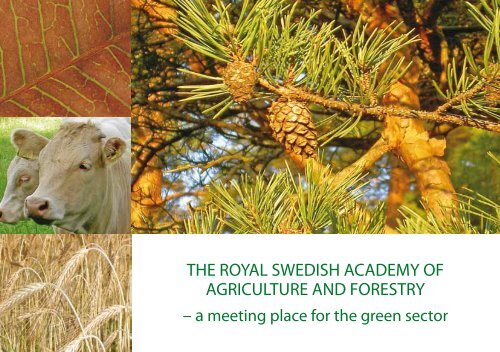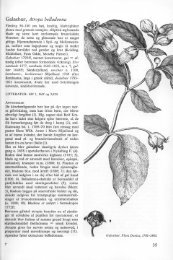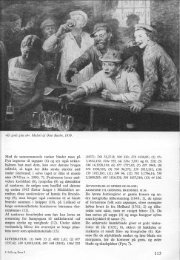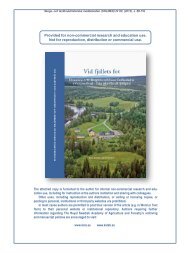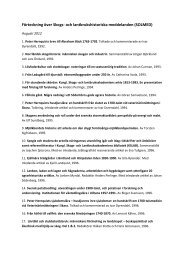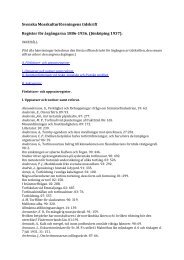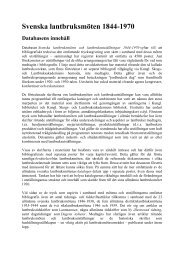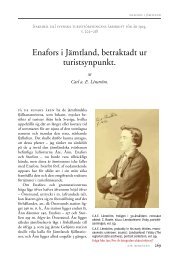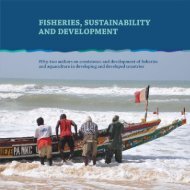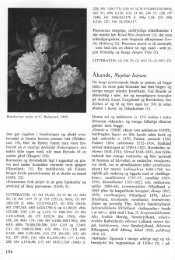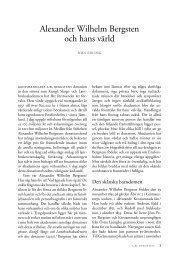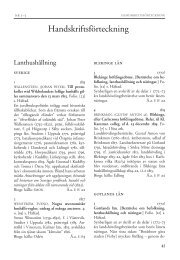the royal swedish academy of agriculture and forestry
the royal swedish academy of agriculture and forestry
the royal swedish academy of agriculture and forestry
You also want an ePaper? Increase the reach of your titles
YUMPU automatically turns print PDFs into web optimized ePapers that Google loves.
THE ROYAL SWEDISH ACADEMY OF<br />
AGRICULTURE AND FORESTRY<br />
– a meeting place for <strong>the</strong> green sector
ACADEMY – name given to a seat <strong>of</strong> higher learning or a learned society. The word derives from <strong>the</strong> Greek school founded by<br />
Plato on <strong>the</strong> outskirts <strong>of</strong> A<strong>the</strong>ns, beside an olive grove dedicated to <strong>the</strong> legendary hero Akademos. (From <strong>the</strong> Swedish National Encyclopedia.)<br />
Royal academies in Sweden:<br />
Royal Swedish Academy <strong>of</strong> Fine Arts (founded in 1735)<br />
Royal Swedish Academy <strong>of</strong> Sciences (founded in 1739)<br />
Royal Academy <strong>of</strong> Letters, History <strong>and</strong> Antiquities (founded in 1753)<br />
Royal Academy <strong>of</strong> Music (founded in 1771)<br />
Royal Swedish Society <strong>of</strong> Naval Sciences (founded in 1771)<br />
Swedish Academy (founded in 1786)<br />
Royal Swedish Academy <strong>of</strong> War Sciences (founded in 1796)<br />
Royal Swedish Academy <strong>of</strong> Agriculture <strong>and</strong> Forestry (founded in 1811)<br />
Royal Swedish Academy <strong>of</strong> Engineering Sciences (founded in 1919)<br />
The Royal Gustavus Adolphus Academy for Swedish folk culture (founded in 1932)<br />
The seal <strong>of</strong> <strong>the</strong> Royal Swedish Academy <strong>of</strong> Agriculture <strong>and</strong> Forestry depicts Ceres,<br />
<strong>the</strong> Roman goddess <strong>of</strong> vegetation <strong>and</strong> <strong>agriculture</strong>, known to <strong>the</strong> ancient Greeks as Demeter.
The Royal Swedish Academy <strong>of</strong> Agriculture <strong>and</strong> Forestry (KSLA)<br />
– a meeting place for <strong>the</strong> green sector<br />
The Royal Swedish Academy <strong>of</strong> Agriculture <strong>and</strong> Forestry<br />
is a free <strong>and</strong> independent network organisation<br />
for <strong>the</strong> advancement <strong>of</strong> <strong>agriculture</strong>, horticulture,<br />
fishing, aquaculture, food, <strong>forestry</strong>, forest products,<br />
reindeer herding, bioenergy, environment, tourism,<br />
recreation <strong>and</strong> <strong>the</strong> history <strong>of</strong> <strong>forestry</strong> <strong>and</strong> <strong>agriculture</strong>.<br />
We work, through non-affiliated dialogue <strong>and</strong> analyses,<br />
on issues that concern all <strong>and</strong> interest many!<br />
KSLA has around 600 Swedish, overseas <strong>and</strong><br />
honorary fellows. Our work is carried out by boards,<br />
committees <strong>and</strong> working parties, <strong>and</strong> in addition to<br />
Academy meetings we hold conferences <strong>and</strong> seminars,<br />
etc. KSLA administers a number <strong>of</strong> funds for<br />
<strong>the</strong> distribution <strong>of</strong> prizes, awards, scholarships <strong>and</strong><br />
research grants. The Academy replies to referrals in<br />
issues concerning <strong>the</strong> green sector.<br />
An independent <strong>academy</strong><br />
The Academy is an independent, autonomous or-<br />
ganisation that appoints its own fellows <strong>and</strong> that<br />
works on questions initiated by its fellows. KSLA<br />
has access to funds <strong>of</strong> its own <strong>and</strong> also administers<br />
a number <strong>of</strong> foundations for which <strong>the</strong> benefactors<br />
have specified <strong>the</strong> purpose <strong>and</strong> use. A common feature<br />
<strong>of</strong> all <strong>the</strong>se foundations is that <strong>the</strong>y aim to promote<br />
scientific research <strong>and</strong> development within <strong>the</strong><br />
green sector.<br />
Brief history<br />
The ‘Royal Swedish Academy <strong>of</strong> Agriculture’ was<br />
founded in 1811 on <strong>the</strong> initiative <strong>of</strong> Crown Prince<br />
Carl Johan, later King Karl XIV Johan <strong>of</strong> Sweden.<br />
He probably had <strong>the</strong> French Academy <strong>of</strong> Agriculture<br />
as his model. Crown Prince Carl Johan also<br />
became <strong>the</strong> first president <strong>of</strong> <strong>the</strong> Academy. At that<br />
time, around 85 % <strong>of</strong> <strong>the</strong> population <strong>of</strong> Sweden were<br />
involved in <strong>agriculture</strong> <strong>and</strong> <strong>the</strong> Academy acted as a<br />
central administration body.<br />
3
Many current Swedish institutions within <strong>the</strong><br />
green sector have <strong>the</strong>ir origins in <strong>the</strong> Academy:<br />
The Ministry <strong>of</strong> Rural Affairs, The Swedish Board<br />
<strong>of</strong> Agriculture <strong>and</strong> a large section <strong>of</strong> <strong>the</strong> research<br />
council Formas are but a few. For many years, <strong>the</strong><br />
Academy supervised <strong>the</strong> Rural Economy <strong>and</strong> Agricultural<br />
Societies <strong>and</strong> also directed agricultural research<br />
activities, a task that was later taken over by<br />
<strong>the</strong> Swedish University <strong>of</strong> Agricultural Sciences. In<br />
1956, forest activities were intensified <strong>and</strong> <strong>the</strong> name<br />
<strong>of</strong> <strong>the</strong> Academy was changed to ‘The Royal Swedish<br />
Academy <strong>of</strong> Agriculture <strong>and</strong> Forestry’.<br />
Organisation<br />
The Academy is led by its President (chairman),<br />
with a vice-President as deputy. The m<strong>and</strong>ate period<br />
for both is four years. The Academy Collegium acts<br />
as <strong>the</strong> Academy’s governing body. The Collegium is<br />
made up <strong>of</strong> <strong>the</strong> President, vice-President, Academy<br />
Secretary, Chairs <strong>of</strong> <strong>the</strong> three Sections <strong>and</strong> a fur<strong>the</strong>r<br />
nine delegates, <strong>of</strong> which each Section elects three.<br />
The Academy Presidium (<strong>the</strong> Collegial Working<br />
Party) is made up <strong>of</strong> <strong>the</strong> President, vice-President<br />
<strong>and</strong> Academy Secretary. The daily work <strong>of</strong> <strong>the</strong> Academy<br />
is directed by <strong>the</strong> Academy Secretary, who is<br />
also managing director <strong>and</strong> head <strong>of</strong> <strong>the</strong> Academy<br />
secretariat.<br />
5
Academy activities<br />
Three sections<br />
Within <strong>the</strong> Academy <strong>the</strong>re are three sections: <strong>the</strong><br />
General Section, <strong>the</strong> Agricultural Section <strong>and</strong> <strong>the</strong><br />
Forestry Section. Each section consists <strong>of</strong> Swedish<br />
fellows, overseas fellows <strong>and</strong> honorary fellows.<br />
The Academy’s activities are carried out within<br />
its boards, committees <strong>and</strong> working parties, <strong>and</strong><br />
through meetings, conferences <strong>and</strong> seminars. Both<br />
Academy fellows <strong>and</strong> external forces are involved in<br />
<strong>the</strong> work <strong>and</strong> <strong>the</strong> Academy endeavours to ga<strong>the</strong>r <strong>the</strong><br />
best available expertise for constructive debate.<br />
The fellows – <strong>the</strong> most important resource<br />
Academy fellows come from research, practice, administration<br />
<strong>and</strong> industry, but represent <strong>the</strong> Academy<br />
in <strong>the</strong>ir personal expertise. The task <strong>of</strong> <strong>the</strong> secretariat<br />
staff is to inspire <strong>and</strong> enable fellows to <strong>of</strong>fer<br />
<strong>the</strong>ir collective experience <strong>and</strong> knowledge for <strong>the</strong><br />
‘good <strong>of</strong> society’, as stated in <strong>the</strong> Academy’s mission<br />
statement. Fellows turning 65 years <strong>of</strong> age usually<br />
do not reduce <strong>the</strong>ir involvement – on <strong>the</strong> contrary,<br />
many see increased opportunities to contribute to<br />
<strong>the</strong> work <strong>of</strong> <strong>the</strong> Academy on retirement from <strong>the</strong>ir<br />
pr<strong>of</strong>essional posts.<br />
New fellows are elected on proposals from existing<br />
fellows, with <strong>the</strong> aim <strong>of</strong> complementing <strong>and</strong><br />
extending <strong>the</strong> Academy’s expertise in actively working<br />
towards positive development <strong>of</strong> <strong>the</strong> green sector.<br />
Election <strong>of</strong> new fellows takes place once a year<br />
<strong>and</strong> is ratified at <strong>the</strong> December meeting.<br />
Boards <strong>and</strong> committees<br />
Within <strong>the</strong> Academy <strong>the</strong>re are permanent boards for<br />
finance, prizes <strong>and</strong> awards, grant allocation <strong>and</strong> library<br />
<strong>and</strong> archives.<br />
7
Within KSLA <strong>the</strong>re are committees that work on:<br />
• Energy issues<br />
• Research policy<br />
• International <strong>forestry</strong> issues<br />
• International agricultural issues<br />
• Rural development<br />
• Food quality <strong>and</strong> health<br />
• Sustainable development<br />
• Forest techniques <strong>and</strong> logistics<br />
• Silviculture<br />
• Fishery issues<br />
• Development <strong>of</strong> pr<strong>of</strong>itable agricultural production<br />
• Water issues<br />
Projects<br />
The Academy also works in more short-term projects<br />
involving reviews <strong>of</strong> interdisciplinary knowledge,<br />
syn<strong>the</strong>ses <strong>and</strong> future studies within areas<br />
identified by <strong>the</strong> Academy as being particularly important<br />
for <strong>the</strong> future development. One such project<br />
is <strong>the</strong> Secretariat for International Forest Issues<br />
(SIFI), www.sifi.se.<br />
Research grants <strong>and</strong> scholarships<br />
Over <strong>the</strong> years, <strong>the</strong> Academy has received various<br />
donations, from which funds are distributed in <strong>the</strong><br />
form <strong>of</strong> research grants <strong>and</strong> travel scholarships that<br />
contribute to <strong>the</strong> development.<br />
Prizes <strong>and</strong> awards<br />
To inspire increased knowledge within <strong>the</strong> Academy’s<br />
areas <strong>of</strong> activity, <strong>the</strong> Academy distributes<br />
prizes <strong>and</strong> awards to deserving practitioners, re-<br />
searchers <strong>and</strong> research organisations. These are<br />
awarded at <strong>the</strong> formal meeting <strong>of</strong> <strong>the</strong> Academy on<br />
28 January each year. The prizes include:<br />
• The A.W. Bergsten Prize, awarded to ‘individuals<br />
who through outst<strong>and</strong>ing scientific work, successful<br />
teaching or comparable practical work have contributed<br />
towards awakening attention <strong>and</strong> interest for <strong>agriculture</strong><br />
<strong>and</strong> its associated sectors’.<br />
• The Academy’s Supreme Gold Medal ‘ for particularly<br />
outst<strong>and</strong>ing lifetime achievements within <strong>the</strong><br />
Academy’s field <strong>of</strong> work’.<br />
• The Academy’s Gold Medal ‘ for extraordinary<br />
achievements within <strong>the</strong> Academy’s field <strong>of</strong> activity’.<br />
9
• The Academy’s Silver Plaquette ‘ for having in a deserving<br />
way awakened interest in <strong>the</strong> l<strong>and</strong>-based industries’.<br />
Historical activities<br />
The Academy’s unit for forest <strong>and</strong> agricultural history<br />
<strong>of</strong> l<strong>and</strong>-based industries (ANH) carries out<br />
inter-disciplinary research into <strong>the</strong> history <strong>of</strong> forest<br />
<strong>and</strong> <strong>agriculture</strong>. The aim is to create an underst<strong>and</strong>ing<br />
<strong>of</strong> <strong>the</strong> importance <strong>of</strong> developing <strong>the</strong>se industries,<br />
to enhance <strong>the</strong> self-image <strong>of</strong> people working<br />
in <strong>the</strong> green sector <strong>and</strong> to provide historical background<br />
when <strong>the</strong> Academy is dealing with current<br />
<strong>and</strong> future issues. The unit also has an active <strong>and</strong><br />
well-equipped research library that specialises in<br />
<strong>the</strong> history <strong>of</strong> <strong>the</strong> l<strong>and</strong>-based industries. This library<br />
is also available to <strong>the</strong> public. Its literature is listed<br />
in <strong>the</strong> LIBRIS database, which is available on <strong>the</strong><br />
internet. KSLA also has comprehensive archives<br />
containing material on <strong>the</strong> Academy’s activities <strong>and</strong><br />
reflecting <strong>the</strong> development <strong>of</strong> Swedish <strong>agriculture</strong>.<br />
Publications<br />
The Academy’s journal (KSLAT) contains lectures<br />
<strong>and</strong> discussions from Academy meetings, seminars<br />
<strong>and</strong> conferences, as well as reports from <strong>the</strong> Academy’s<br />
committees <strong>and</strong> working parties. Certain issues<br />
<strong>of</strong> KSLAT are only published on <strong>the</strong> Academy<br />
website www.ksla.se, where <strong>the</strong> printed issues are<br />
available as download files. Collaborative projects<br />
with o<strong>the</strong>r organisations are <strong>of</strong>ten published in separate<br />
issues.<br />
A digital quarterly newsletter with shorter accounts<br />
<strong>of</strong> <strong>the</strong> Academy’s activities is also published.<br />
In addition, <strong>the</strong> Academy publishes books on <strong>the</strong><br />
history <strong>of</strong> <strong>the</strong> l<strong>and</strong>-based industries in <strong>the</strong> book series<br />
Skogs- och Lantbrukshistoriska meddel<strong>and</strong>en<br />
(SOLMED) <strong>and</strong> <strong>the</strong> pamphlet series Miscellanea,<br />
which consists <strong>of</strong> personal bibliographies, literature<br />
reviews, etc.<br />
11
Welcome to Enaforsholm!<br />
The Academy runs <strong>the</strong> Enaforsholm estate in western<br />
Jämtl<strong>and</strong>, very suitable for relaxing <strong>and</strong> easily<br />
accessible outdoor activities. Enaforsholm is owned<br />
by <strong>the</strong> A.W. Bergsten Foundation, which is administered<br />
by <strong>the</strong> Academy. The Academy <strong>and</strong> <strong>the</strong> host<br />
couple at Enaforsholm welcome all with an interest<br />
in nature to this paradise, which provides board <strong>and</strong><br />
home-cooked food at very reasonable prices.<br />
Enaforsholm can accommodate guests in 2–8<br />
bed rooms. A couple <strong>of</strong> cottages are equipped for<br />
self-catering. In total, <strong>the</strong>re are around 50 beds. This<br />
outdoor centre is also suitable for small conferences<br />
or private ga<strong>the</strong>rings. The conference facilities can<br />
accommodate up to 35 people.<br />
Enafors <strong>and</strong> its surroundings <strong>of</strong>fer unforgettable<br />
nature <strong>and</strong> culture experiences. Ånnsjön is one <strong>of</strong><br />
<strong>the</strong> most bird-rich lakes in <strong>the</strong> Swedish mountain<br />
region, soapstone products are made in H<strong>and</strong>öl,<br />
while <strong>the</strong> impressive Tännforsen rapids <strong>and</strong> <strong>the</strong><br />
graceful Brudslöjan waterfall are a short car journey<br />
away, as is Storulvån, where many begin <strong>the</strong>ir hikes<br />
in <strong>the</strong> ‘Jämt triangle’ to Blåhammaren <strong>and</strong> Sylarna.<br />
FOR BOOKING AND MORE INFORMATION:<br />
Telephone +46 (0)647-730 26<br />
or + 46 (0)705-27 30 26<br />
E-mail info@enaforsholm.se<br />
Postal address Enaforsholm 289<br />
SE-830 15 Duved<br />
Sweden<br />
See also www.enaforsholm.se<br />
13
The Academy house<br />
The beautiful house belonging to <strong>the</strong> Royal Swedish<br />
Academy <strong>of</strong> Agriculture <strong>and</strong> Forestry is located<br />
at Drottninggatan 95 B in Stockholm, Sweden. It<br />
was built in 1869 <strong>and</strong> was originally designed for<br />
<strong>the</strong> Petrological College <strong>and</strong> <strong>the</strong> country’s petrological<br />
engineers were educated here until 1917. The<br />
house contained laboratories for metallurgical experiments,<br />
lecture <strong>the</strong>atres <strong>and</strong> residential accommodation.<br />
The house was <strong>the</strong>n used by <strong>the</strong> Metallographical<br />
Institute <strong>and</strong> in 1947 <strong>the</strong> Slavonic Institute <strong>of</strong><br />
Stockholm University occupied <strong>the</strong> premises.<br />
The Academy took over <strong>the</strong> house after <strong>the</strong><br />
University moved to Frescati <strong>and</strong> required <strong>the</strong><br />
Academy’s experimental field. The move was completed<br />
in 1972. Extensive renovations were carried<br />
out in 1990. The exterior matches that <strong>of</strong> <strong>the</strong><br />
neighbouring house, <strong>the</strong> former Institute <strong>of</strong> Technology.<br />
Both buildings are in <strong>the</strong> Renaissance style,<br />
with rich stucco architecture. The elegant staircase,<br />
which has remained unchanged since 1869, is an<br />
<strong>of</strong>ficial listed building feature, as is <strong>the</strong> exterior.<br />
If you would like to know more about <strong>the</strong> Royal Swedish Academy <strong>of</strong><br />
Agriculture <strong>and</strong> Forestry, please visit our website: www.ksla.se<br />
15
The task <strong>of</strong> <strong>the</strong> Royal Swedish Academy <strong>of</strong> Agriculture<br />
<strong>and</strong> Forestry is to promote <strong>agriculture</strong> <strong>and</strong> <strong>forestry</strong> <strong>and</strong><br />
<strong>the</strong>ir related fields with <strong>the</strong> support <strong>of</strong> science <strong>and</strong><br />
practical experience in <strong>the</strong> interest <strong>of</strong> society.<br />
The Academy mission statement<br />
Royal Swedish Academy <strong>of</strong> Agriculture <strong>and</strong> Forestry (KSLA)<br />
Drottninggatan 95 B • P. O. Box 6806, SE-113 86 Stockholm, Sweden • Telephone + 46 (0)8-54 54 77 00<br />
Fax +46 (0)8-54 54 77 10 • E-mail akademien@ksla.se • Website www.ksla.se<br />
Production KSLA. Photo <strong>and</strong> layout Kerstin Hideborn Alm. Printed by Gävle Offset AB in September 2011. Edition 1000. ISBN 978-91-85205-40-0.


